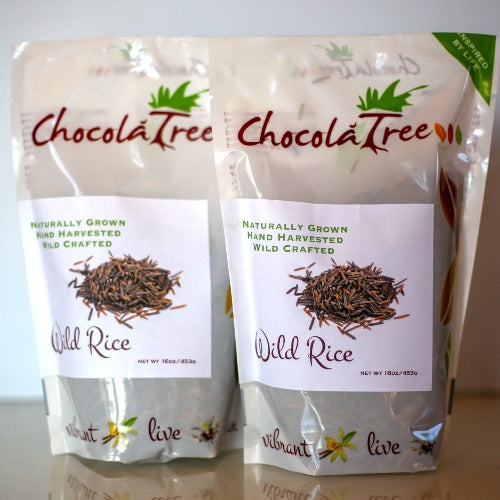Chocolatree Wild Rice, 16 oz

ChocolaTree Organic Oasis
$ 15.00
WILD RICE
16 oz
Organic wild rice grows wild in the clear lakes of northern Minnesota and Canada. It is not genetically modified and has not been altered like some of the cultivated paddy wild rice that is available in grocery stores across the country. We offer this special rice to you now, with love.
The history of wild rice is an interesting one. It is an aquatic cereal grain that grows wild in isolated lakes and river bed areas located primarily within the continent of North America. This evolutionary ancient grain has been found in layers of the earth dating back some 12,000 years. In addition to its role as an important food staple for ancestral peoples, it has provided a unique habitat for fish and waterfowl for thousands of years. The methods used for harvesting wild rice have remained unchanged for centuries. Wild Rice also has many uses, as a grain, as a folk medicine, in ornamental use and in cultural events.
MORE ABOUT WILD RICE
Wild Rice is an aquatic cereal grain that grows "wild" in isolated lakes and river bed areas located primarily within the continent of North America. It is also native to ecologically similar regions located on the continent of Asia. This evolutionary ancient grain has been found in layers of the earth dating back some 12,000 years. In addition to its role as an important food staple for ancestral peoples, it has provided a unique habitat for fish and waterfowl for thousands of years.
Wild Rice is the grain of a reed-like aquatic plant (Zizania palustris), which is unrelated to rice. It is grown in the United States and also in Canada. The grains are long, slender and black, with a distinctive earthy, nutty flavor. It is available in three different grades, giant, which is a very long grain and the best quality, fancy, which is a medium grain and of lesser quality and select, which is a short grain. Wild Rice is an annual grass which grows naturally in many Northern Minnesota and Wisconsin lakes. The Chippewa word for grain of berry is "min." The word mano, meaning good, makes "manomin" (good berry). Wild rice was known by this name manomin to the Chippewa's and to most of the early white explorers and settlers of the Upper Mississippi Valley. Throughout the years, there have been 60 popular names identified for wild rice. English terms were numerous but the most commonly accepted name became wild rice. By whatever name, many of the Indigenous Peoples of North America consider the "wild" varieties of lake and river wild rice to be "A Gift from the Great Spirit...the Creator Himself", spiritually sacred and therefore distinct from the "cultivated" or "farm grown" varieties. Today, the "wild" varieties and the "cultivated" or "farm grown" varieties of wild rice remain an especially important crop for both lake and river producers and modern day farmers.
Manomin gave its name to the moon (month) of harvest, which is typically the end of August to early September in northern Minnesota. Harvest time can be fun, but a lot of hard work is involved, especially processing the grain on the spot, even with some modern aids. This native grass has a very large, erect, branched inflorescence which produces edible grains. Wild-rice usually grows in water and is often planted as wildlife food. Manomin grows as reeds that are anywhere from 8-12 ft. tall. They grow in water that is about 3-8 feet deep in Wisconsin, Minnesota, and marshes north of the Great Lakes. There are thousands of different varieties, each kind growing in its own particular place of depth, temperature, mud, water quality. Wild rice is very sensitive to the environmental conditions of its niche. The plants do not like changes; the species are perfectly adapted to the way things are in different areas, including seasonal water levels, quality, temperature.

